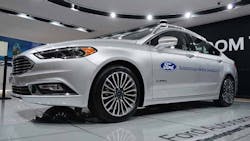What the Rise of the Autonomous Market Means for Edge Computing & Data Centers
Brian Eichman, Director of Solution Architecture and Product Development at CoreSite, explores what the rise of the autonomous market and connected vehicle industry means for the data industry, as well as the role latency and edge computing play in this evolution.
Brian Eichman, Director of Solution Architecture and Product Development, CoreSite
In the not-so-distant past, autonomous vehicles were mere figments of our imaginations. They were nothing more than a fanciful concept like flying cars and personal flight suits you’d see only in sci-fi films or magazines.
How times have changed. Today, thanks to the investments and talents of transportation and technology luminaries, driverless vehicles have logged more than 8 million test miles on public roads and are expected to make up nearly one-quarter of the global vehicle market by 2040.
While truly autonomous cars and trucks are still a ways off from dominating the roadways, by 2027 the global market size of connected cars may reach as high as $213 billion USD, as manufacturers and governments seek to improve travel efficiency, safety, and the overall driver (and passenger) experience.
But while companies continue to make headway in advancing the technologies that enable full autonomy, they’re still at the mercy of limitations of other technologies, namely computing power and capacity.
Transitioning from Organic to Machine-Powered Networks
Self-driving vehicles are powered by and create massive volumes of data. The Automotive Edge Computing Consortium estimates autonomous vehicles could generate up to 5 TB of data per hour. Unlike human-driven automobiles whose speed, direction, and routes for safe arrival at a destination are dictated by a driver’s organic neural network – autonomous vehicles require modern cloud-based machine networks that depend on tightly integrated, low-latency hybrid architectures to effectively aggregate, analyze, and transmit data in real-time ensuring safe and efficient operation on the roadways..
But conventional approaches to data management and network architecture aren’t well suited to handle the massive volumes of data produced by connected or autonomous vehicles. Traditional IT infrastructure and legacy networks in corporate data centers weren’t designed for the enormous compute power and storage capacity connected vehicles require. Corporate data centers also lack the direct, low-latency connectivity, easy updates, and unbreakable data security measures required to keep autonomous systems running safely at optimal performance..
The New Speed Limit: Latency
Perhaps more than any other industry, autonomous vehicles are highly latency-sensitive. All the data collected from on-board processors and external sources like roadside monitors, GPS, and other vehicles must be aggregated, analyzed, and transmitted in real-time without fail. Even the slightest delay in any of those processes can radically change the driving experience for the worse.
As such, automotive companies must shift to modern application architectures that seamlessly couple high-performance compute and scalable storage capacity with low-latency connectivity between vehicles, data platforms, and critical IT service providers. . They must realize that to reliably and securely store huge volumes of data, extract valuable insights from that information, and instantly connect vehicles with data sources and each other, they’ll need a modern strategy which will require close collaboration across stakeholders, suppliers, and partners.
To be successful, it is best to first partner with an experienced colocation partner with on-net, low-latency access to leading terrestrial and mobile network service providers, but are also adjacent to key cloud availability zones. In addition to the foundational interconnection services, with the data center provider must offer rapid scalability to support virtually any amount of data the roadways of the future will command. To that end, hybrid-ready data centers will be the expressway for our transition from human-driven to driverless, fully autonomous vehicles.
At the Edge of a Breakthrough
Beyond the power and density of modern data center facilities, cloud-enabled data centers provide low-latency burst capabilities to additional compute and storage capacity through direct connections to the public cloud providers like AWS, Google, and Azure.
But the real difference maker — what will ultimately enable the dream of full autonomy to become reality — is the additional compute and storage capacity available at strategically located edge facilities in other availability zones that enable processing information closer to the user, dramatically reducing latency by as much as 50%.
Edge computing will simplify and accelerate processing and finding patterns in on-board sensor data using artificial intelligence and machine learning applications. Moreover, keeping sensor data closer to the vehicles means less time spent waiting for data to make a driving decision. Edge computing is what will enable cars to talk to traffic signals in real-time to stop or start, or communicate road accidents much quicker than currently possible, according to some industry experts.
As automotive technologies and other “smart” elements of the transportation apparatus continue to evolve, so too must the infrastructure behind it. Hybrid-ready data centers will provide the scale, capacity, power, and connectivity required to make an idea that was once just a dream the norm of our everyday reality.
Brian Eichman is Director of Solution Architecture and Product Development at CoreSite and was previously was responsible for CoreSite’s corporate IT. Contact us today to learn more about how CoreSite’s comprehensive suite of colocation and cloud connectivity solutions are powering innovation and tomorrow’s technologies.

